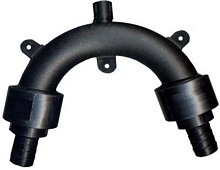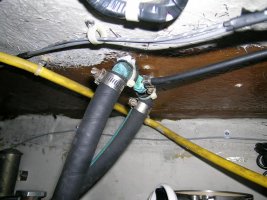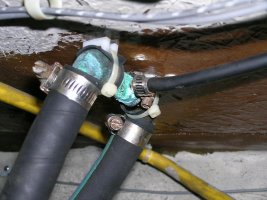Frank Langer
1984 Ericson 30+, Nanaimo, BC
Hi,
I thought I understood most of my boat systems, but was perplexed yesterday, so would appreciate any help on the hoses going out the transom of our 1984 Ericson 30+. I had to replace two small nylon thru hulls, one of which had a red 5/8" hose attached which came up from the bilge area near the rudder post. The other is a black rubber hose about 1/4" coming from the engine compartment which attached to a bronze nipple and the other part of the bronze piece screwed onto the nylon thru hull. Neither of these is the exhaust hose (which is much larger) or the bilge hose which is also larger. Neither is the fuel tank vent hose, which is separate. Can anyone explain what these two hoses do?
My second question relates to the bronze fitting which is screwed onto the nylon thru hull. I put some lanolin on the thru hull to help this bronze piece thread onto it and tightened it reasonably tight with a wrench, but keeping in mind that I didn't want to break the nylon thru hull. I'm now wondering if I needed to add teflon tape or pipe thread stuff to keep it from leaking. I'm not at the boat to check for leaks--does anyone know if I need to take it apart again or will it likely be ok?
Thanks for any help with this.
Frank
I thought I understood most of my boat systems, but was perplexed yesterday, so would appreciate any help on the hoses going out the transom of our 1984 Ericson 30+. I had to replace two small nylon thru hulls, one of which had a red 5/8" hose attached which came up from the bilge area near the rudder post. The other is a black rubber hose about 1/4" coming from the engine compartment which attached to a bronze nipple and the other part of the bronze piece screwed onto the nylon thru hull. Neither of these is the exhaust hose (which is much larger) or the bilge hose which is also larger. Neither is the fuel tank vent hose, which is separate. Can anyone explain what these two hoses do?
My second question relates to the bronze fitting which is screwed onto the nylon thru hull. I put some lanolin on the thru hull to help this bronze piece thread onto it and tightened it reasonably tight with a wrench, but keeping in mind that I didn't want to break the nylon thru hull. I'm now wondering if I needed to add teflon tape or pipe thread stuff to keep it from leaking. I'm not at the boat to check for leaks--does anyone know if I need to take it apart again or will it likely be ok?
Thanks for any help with this.
Frank



